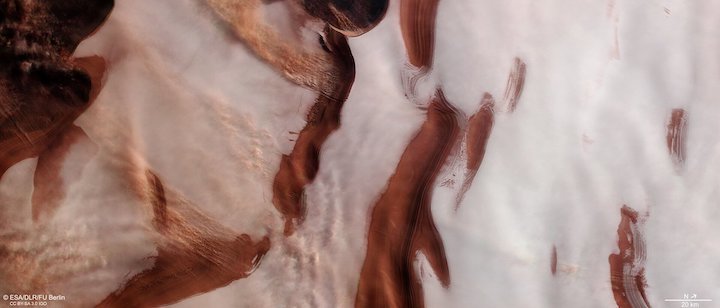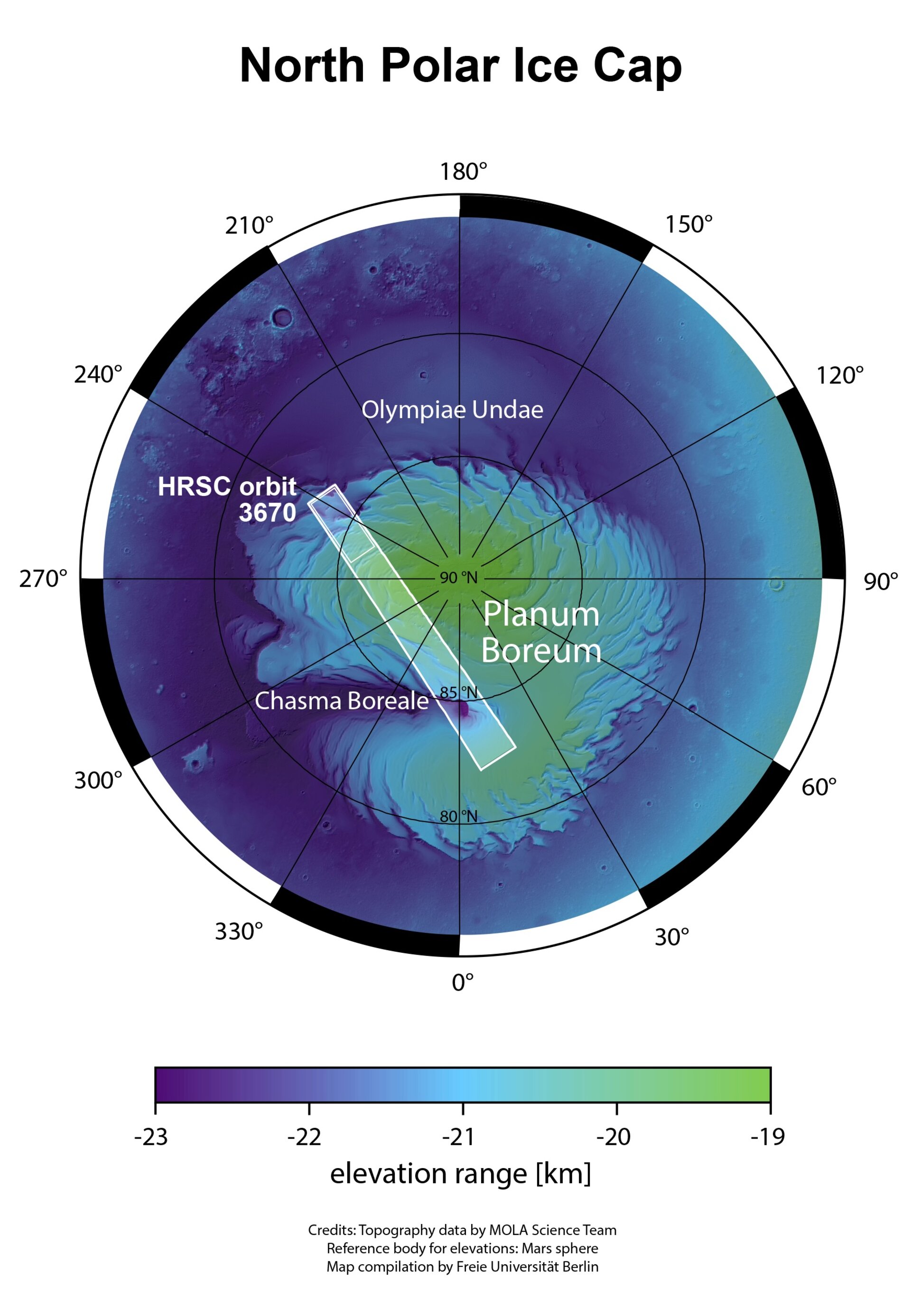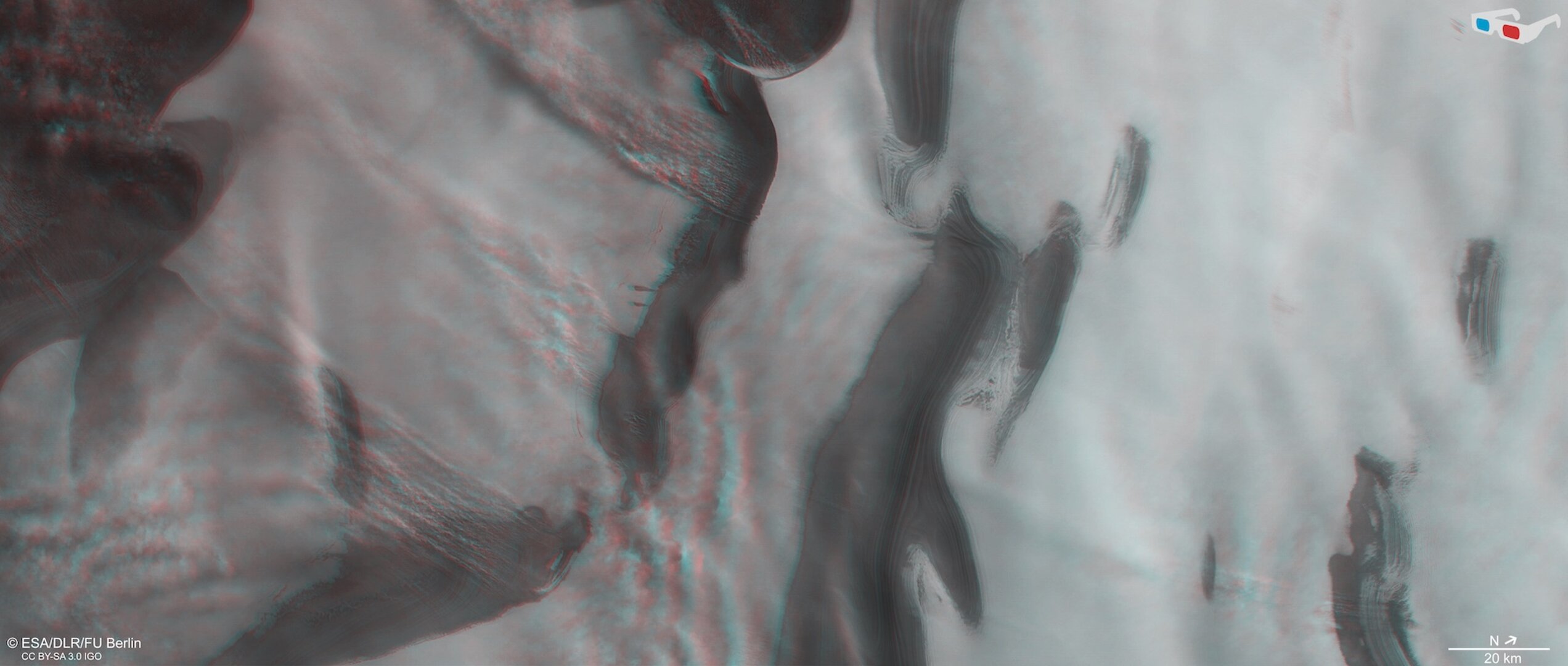14.01.2020

ESA’s Mars Express has captured beautiful images of the icy cap sitting at Mars’ north pole, complete with bright swathes of ice, dark troughs and depressions, and signs of strong winds and stormy activity.
The poles of Mars are covered in stacked layers of ice that subtly shift in extent and composition throughout the year.
During summer, the pole is permanently covered by thick layers of mostly water ice; during winter, temperatures plummet below -125 degrees Celsius and carbon dioxide begins to precipitate and build up as ice, creating a thinner additional layer a couple of metres thick. Winter also brings carbon dioxide clouds, which can obscure the polar features below and make it difficult to see clearly from orbit.

This view from Mars Express’ High Resolution Stereo Camera (HRSC) suffers from very little such cloud cover, and shows the northern polar cap during the summer of 2006.
The landscape is a rippled mix of colour, from the bright whites of water ice to the dark reds and browns of martian dust, and displays a number of interesting phenomena.
Dark red and ochre-hued troughs appear to cut through the ice cap. These form part of a wider system of depressions that spiral outwards from the very centre of the pole. When viewed on a larger scale, as in the context map, this pattern becomes evident: the rippling troughs curve and bend and slice outwards in an anti-clockwise orientation, wrapping around the pole and creating a pattern akin to zebra stripes.
These spiralling features are thought to have formed via a mix of processes, the most significant one being wind erosion. It is thought that winds circle radially away from the centre of the north pole, moving outwards cyclically to create the spiral pattern we see.

These winds, known as katabatic winds, move cold, dry air downslope under the force of gravity, often originating in areas of higher elevation (such as glaciers or snow-covered plateaus) and flowing down into lower, warmer areas such as valleys and depressions. They are acted upon by the Coriolis force as they move, which causes them to deviate from a straight path and form the aforementioned spiral pattern we see.
Visible to the left of the frame are a few extended streams of clouds, aligned perpendicularly to a couple of the troughs. These are thought to be caused by small local storms that kick up dust into the martian atmosphere, eroding scarps and slopes as they do so and slowly changing the appearance of the troughs over time.
The poles, and any active processes taking place in these regions, are particularly interesting areas of Mars. These layers of ice hold information about Mars’ past, particularly concerning how its climate has evolved and changed in the last few millions of years: ice mixes with layers of surface dust and settles at the north and south poles, capturing a snapshot of the planet’s characteristics during that period of history.
A key goal of HRSC is to explore the various phenomena occurring in the martian atmosphere, such as winds and storms, and the many intriguing geological processes that take place across – and below – the Red Planet’s surface.
The camera has been returning impressively detailed views of Mars for many years. Mars Express arrived at the Red Planet in late 2003, and has revealed much about the planet and its history – including mapping its surface at resolutions of 10 m/pixel or greater, exploring how wet and humid early Mars may have been, characterising its amazing volcanoes and bizarre surface features and geography, and probing deeper to determine the structure and components of its sub-surface.
This aim of characterising the entirety of the planet and its history will be continued and furthered by the ESA-Roscosmos ExoMars Trace Gas Orbiter, which arrived at Mars in 2016, and the ExoMars Rosalind Franklin rover and its accompanying surface science platform, which will arrive next year.
This image is published to coincide with the Seventh International Conference on Mars Polar Science and Exploration, which is taking place in Argentina from 13 to 17 January 2020. This is the latest in a series of international and interdisciplinary conferences to share knowledge about the intriguing polar regions of the Red Planet.
Quelle: ESA

